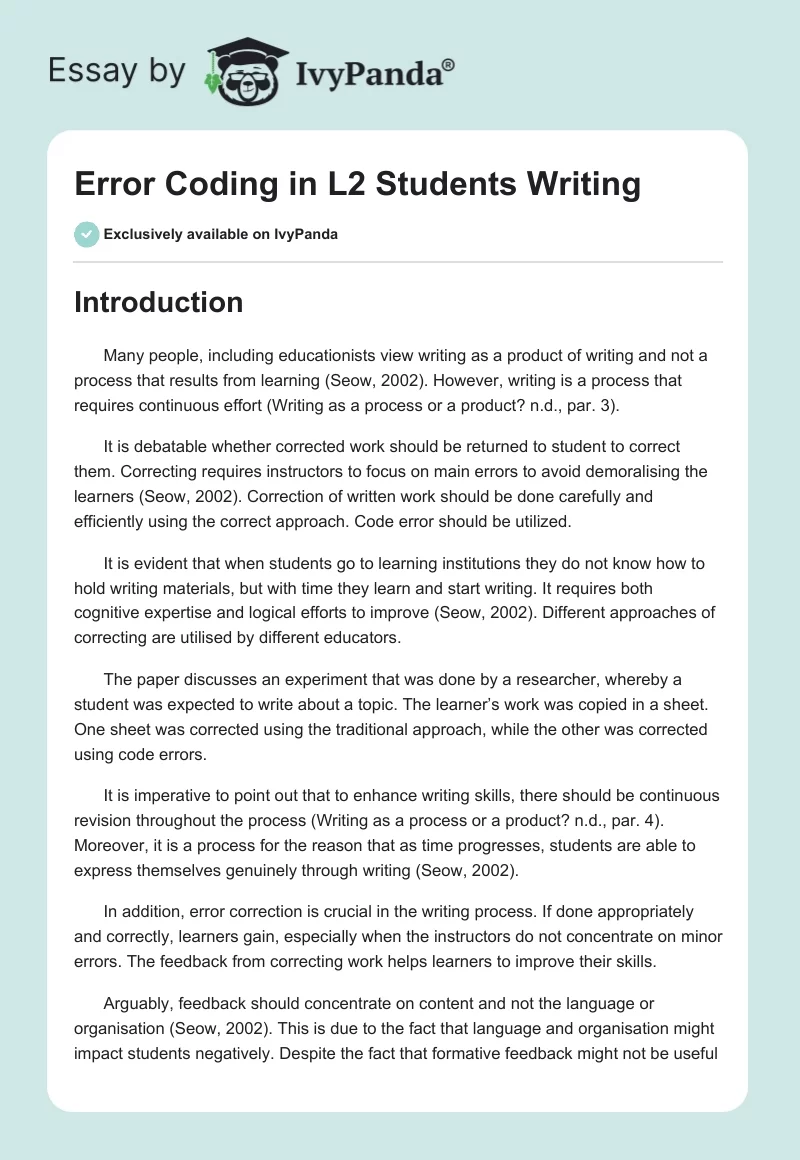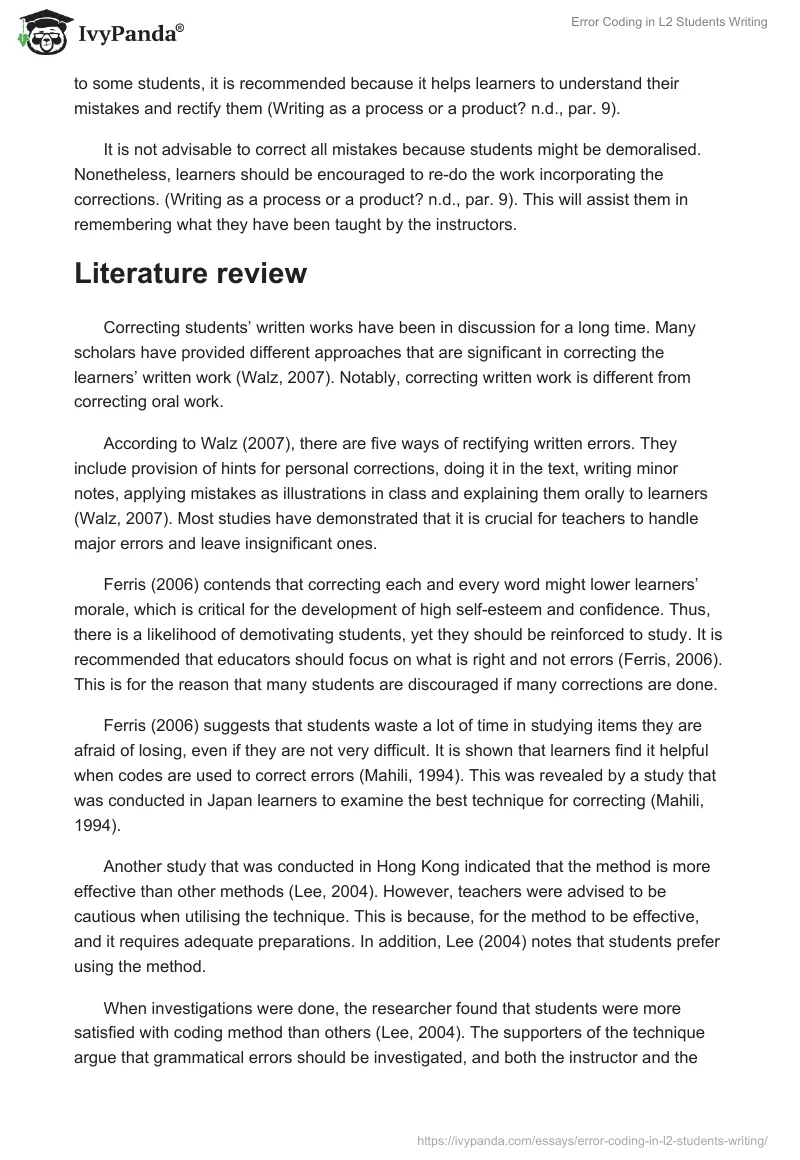Introduction
Many people, including educationists view writing as a product of writing and not a process that results from learning (Seow, 2002). However, writing is a process that requires continuous effort (Writing as a process or a product? n.d., par. 3).
It is debatable whether corrected work should be returned to student to correct them. Correcting requires instructors to focus on main errors to avoid demoralising the learners (Seow, 2002). Correction of written work should be done carefully and efficiently using the correct approach. Code error should be utilized.
It is evident that when students go to learning institutions they do not know how to hold writing materials, but with time they learn and start writing. It requires both cognitive expertise and logical efforts to improve (Seow, 2002). Different approaches of correcting are utilised by different educators.
The paper discusses an experiment that was done by a researcher, whereby a student was expected to write about a topic. The learner’s work was copied in a sheet. One sheet was corrected using the traditional approach, while the other was corrected using code errors.
It is imperative to point out that to enhance writing skills, there should be continuous revision throughout the process (Writing as a process or a product? n.d., par. 4). Moreover, it is a process for the reason that as time progresses, students are able to express themselves genuinely through writing (Seow, 2002).
In addition, error correction is crucial in the writing process. If done appropriately and correctly, learners gain, especially when the instructors do not concentrate on minor errors. The feedback from correcting work helps learners to improve their skills.
Arguably, feedback should concentrate on content and not the language or organisation (Seow, 2002). This is due to the fact that language and organisation might impact students negatively. Despite the fact that formative feedback might not be useful to some students, it is recommended because it helps learners to understand their mistakes and rectify them (Writing as a process or a product? n.d., par. 9).
It is not advisable to correct all mistakes because students might be demoralised. Nonetheless, learners should be encouraged to re-do the work incorporating the corrections. (Writing as a process or a product? n.d., par. 9). This will assist them in remembering what they have been taught by the instructors.
Literature review
Correcting students’ written works have been in discussion for a long time. Many scholars have provided different approaches that are significant in correcting the learners’ written work (Walz, 2007). Notably, correcting written work is different from correcting oral work.
According to Walz (2007), there are five ways of rectifying written errors. They include provision of hints for personal corrections, doing it in the text, writing minor notes, applying mistakes as illustrations in class and explaining them orally to learners (Walz, 2007). Most studies have demonstrated that it is crucial for teachers to handle major errors and leave insignificant ones.
Ferris (2006) contends that correcting each and every word might lower learners’ morale, which is critical for the development of high self-esteem and confidence. Thus, there is a likelihood of demotivating students, yet they should be reinforced to study. It is recommended that educators should focus on what is right and not errors (Ferris, 2006). This is for the reason that many students are discouraged if many corrections are done.
Ferris (2006) suggests that students waste a lot of time in studying items they are afraid of losing, even if they are not very difficult. It is shown that learners find it helpful when codes are used to correct errors (Mahili, 1994). This was revealed by a study that was conducted in Japan learners to examine the best technique for correcting (Mahili, 1994).
Another study that was conducted in Hong Kong indicated that the method is more effective than other methods (Lee, 2004). However, teachers were advised to be cautious when utilising the technique. This is because, for the method to be effective, and it requires adequate preparations. In addition, Lee (2004) notes that students prefer using the method.
When investigations were done, the researcher found that students were more satisfied with coding method than others (Lee, 2004). The supporters of the technique argue that grammatical errors should be investigated, and both the instructor and the student should have the same understanding of the concepts that would be used in coding (Lee, 2004).
This is crucial in enhancing communication between them. Furthermore, teachers should draw their attention on enlightening learners with items that are related to specific codes. This will facilitate the correction process, reducing the time that would be spent by students to guess.
Explanations of the researcher’s experiment of correcting written work with codes
The researcher’s personal experiment reveals involved written work from a student that was submitted for marking. The two sheets were given to two different teachers to mark. One of the teachers was expected to identify the mistakes by use of codes, while the other was required to mark the sheet.
It was evident that the teacher who used codes took shorter time compared with the one who scored the paper by writing the answers. In addition, the first teacher gave back the paper for the learner to correct herself. From the scholar’s experiment, it is evident that coding is efficient and effective with regard to saving time and energy.
This is for the reason that the instructor who used codes took a shorter time to score the sheet. Notably, there is a big difference, i.e. 00.22.02 hours. This time could have been used in other activities. The coding error method is efficient because learners also get time to revise corrections that have been made.
Giving the learners their work to correct is important in helping them to recall, avoiding similar mistakes in the future. In fact, despite the fact that the instructor who utilized code spent less time does not mean he or she used a lot of energy. The energy applied is less using coding errors than the one that is spent in writing
Usefulness of coding errors in saving time
As aforementioned, coding as a technique of correcting is advantageous in error correction and saving time. First, it has fewer mistakes compared with the traditional strategic approach (Ho, 2004). As a result, the time that would be spent on handling errors for each student is saved.
Short time is utilised to provide high-quality performance outcomes (Ho, 2004). From the researcher’s experiment, it is notable that learners discover their inaccuracies in their written work and refer to the checklists that have been provided by the educator. They are also free to access any information that is useful in correcting the errors and relate with their fellow students to correct mistakes, leading to an increase in gaining of knowledge within the shortest time possible (Ho, 2004).
In addition, many errors can be corrected within a short period of time as revealed in the experimental results. Less energy is employed by the instructor in coding than it would have been the case if he or she corrected individual work. This would be tiresome, and a lot of energies would be applied.
Coding mistakes were helpful to learners because they were provided support by the checklists and the materials that had been used by the previous class (Ho, 2004). It also improved their memory because experience is the best teacher. Learning by doing increases memory retention.
The scholar’s experimental results reveal a lot of information about coding errors. They indicate that coding errors is efficient and effective compared with the traditional approach. This implies that error code is an appropriate methodology, especially at the initial stages (Ho, 2004).
The method advances linguistic competence. Nonetheless, the researcher contented that it is the best way of helping students to solve problems with regard to correcting written work. It enables learners to construct a grammatical composition with the aim of making them more adequate than it would be if other strategies are utilised (Ho, 2004).
It is evident from the results that there should be a design that would yield the best effects. The design should be clear and easily recalled to produce the desirable effects. The strategy that is vital in achieving the desired effects is apparent from the results (Ho, 2004). This involves preparing the learners mentally about the questions they would ask their teacher, making the process successful.
Reference resources are critical in coding errors. In cases where learners encounter difficulties, they consult reference materials. Some learners are lazy and do not engage in coding errors (Ho, 2004). The researcher concluded that the habit could have resulted from the system of education that spoon-feeds students.
Another conclusion that was made was that students could have been busy with other activities and did not have time to carry out the research proposal. Failure of the software to perform complex tasks made the learners feel frustrated.
Conclusion/suitability of the method
In conclusion, error coding is crucial in correcting written work. Arguably, error correction through coding is the most appropriate method to correct written works. According to the researcher’s experiment, it saves time and energy, making it effective and efficient.
Accuracy is promoted when code errors are used. In addition, it promotes independent thinking among intermediate stage student, i.e., the beginners. This is the case, especially when learners are given their work to correct. Furthermore, writing is a process that engages various activities that promote learning.
It is learning in itself and is achieved gradually through reinforced practice. Therefore, the method should be encouraged and practised by the instructors because it saves time for both the instructor and the learner. The two teachers from the experiment used different approaches to correct errors and coding error proved best in relation to saving time.
Recommendations
Using the researcher’s experiment, these recommendations concentrates on guiding what should be done to facilitate error corrections. First, further studies should be carried out to investigate more about error correction using error codes.
Second, it is advisable to use more students in the study than the one that were used in the experiment. More students should be involved in conducting the research to get different views about the application of coding errors. The duration of conducting the research should be increased for comprehensive data collections and analysis.
Students should be given their papers back to make correction as evidenced in the experiment. This will motivate them to learn more. Nevertheless, time should be spent by both educators and students to familiarise themselves with the rules governing the usage of the technique.
References
Ferris, D. R. (2006). Does error feedback help student writers? New evidence on the short-and long-term effects of written error correction. Feedback in second language writing: Contexts and issues, 8(4), 81-104.
Ho, B. (2004). Using Error Codes to Help Error Correction: Working Papers in English &Communication. Web.
Lee, I. (2004). Error correction in L2 secondary writing classrooms: The case of Hong Kong. Journal of Second Language Writing, 13(4), 285-312.
Mahili, I. (1994). Responding to student writing. Web.
Seow, A. (2002). The writing process and process writing. Methodology in language teaching: An anthology of current practice, (23)4, 315-320.
Walz, J. C. (2007). Error Correction Techniques for the Foreign Language Classroom. Web.
Writing as a process or a product? (n.d). Web.


